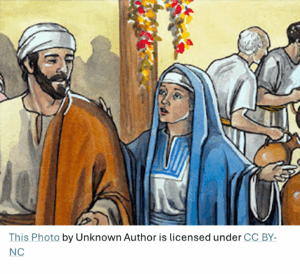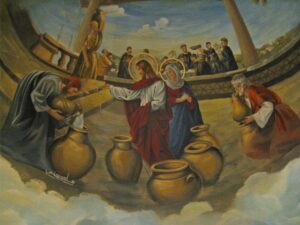When Water Became Wine
The story of the Wedding at Cana has long captured my imagination — a son’s reluctance, a mother’s persistence and joy restored, just as it was about to falter. Beneath the familiar surface there also lies something deeper: a picture of divine abundance, of human partnership with God, the beginnings of a ministry that would change the world with the final cutting of an umbilical cord.
Jesus’ first miracle, according to John’s Gospel, wasn’t on a mountaintop or in a synagogue but at a village wedding. The scene is Cana of Galilee — a small community in the Galilean hills, a few miles east of Nazareth. Cups chink in this setting that is intimate, joyful, and deeply human: family, friends, music, and the hum of conversation as guests celebrate a union.

The Season of Joy
In Jesus’ time, weddings were community-wide feasts that lasted several days. The prime wedding season was October, after the Jewish High Holy Days of Rosh haShanah, Yom Kippur and Sukkot — between the grape and olive harvests and ahead of the winter rains that followed ploughing. It was optimally a time of abundance and mild weather, facilitating travel on Israel’s dusty roads and celebration.
By the autumn wedding season, Jesus had returned to Galilee from his baptism and temptation in the wilderness. Along with him were six disciples. They didn’t need an invitation to the wedding: all were welcome to share in the joy.
“They Have No Wine”
Running out of wine was as deeply embarrassing for the hosts then as it would be today. Mary’s sense of responsibility — and her confident direction to the servants — possibly suggest more than a casual connection to the bride and groom. This may have been a family wedding — one of Jesus’ younger sisters, perhaps.

Mary tells Jesus: “They have no wine.”
He answers, “Woman, what is that to you and to me? My hour has not yet come.”
To our ears, “Woman” sounds abrupt, but in Aramaic and Greek it carried the formal respect of “Madam” or “Lady.” Still, there was distance. It was not Imma —“Mother.” Jesus’ words signal a shift: his mission now answers to his heavenly Father, which has precedence over family ties. In that moment, it is as though the umbilical cord— once literal and that became emotional and spiritual — is being gently but firmly severed. His hour has come and Mary knows it. Jesus will step fully into his divine vocation, no longer defined by family but by calling.
Undeterred, she presses forward confidently, as if divinely guided, urging her son to overcome his hesitation to demonstrate his divine power. “Do whatever he tells you,” she tells the servants.
The Miracle

Nearby stood six large stone water jars, used for the ritual washing of hands before meals — the Jewish practice of purification. Jesus instructed that they be filled with water. When the steward tasted what was then drawn out, it had become wine — not just any wine, but finer than the finest served at any wedding.
At weddings of the time, the groom was responsible for supplying the wine so it was he the steward congratulated: “Everyone serves the good wine first, and then the inferior after the guests have drunk freely; but you have kept the best until now!” For those who, like Mary, knew what had happened, the focus has shifted from the earthly bridegroom at this wedding to the heavenly one.
The six jars for ritual handwashing ahead of a meal point also to the Jewish mikvah immersion bath for self-purification, and to the six days of God’s Creation, sending the message that Jesus is both pure and a New Creation.
The True Bridegroom
John concludes: “Jesus revealed his glory, and his disciples believed in him.” His marriage is covenant-sealed just like the ketubah wedding contract that the couple at this wedding and Mary herself would have entered into, ahead of marriage. Jesus’ ketubah is with us, his people. We are the bride.
The story of the wedding at Cana invites us to recognize that divine abundance can spring from moments of lack — the sometimes empty jars of our lives can be filled by Jesus with something new and wonderful.
Mary
Cana also marks a turning point for Mary. As those present become Jesus’ bride, as ‘woman’ she now stands on the outside, watching a mission she cannot shape, only witness, frequently in fear and pain.

She will learn that although her role as mother is finished, her calling as disciple is just beginning. We will find her no longer directing servants at a feast, but leading prayer in the upper room. The water of Mary’s motherhood will become the wine of her faith.
Don’t forget to subscribe to my posts and weekly newsletter in the sidebar.


